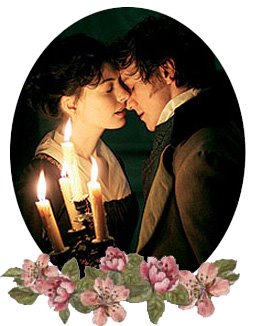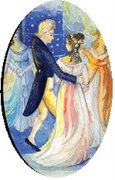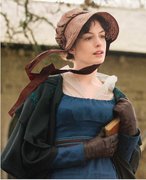The title alone suggests that this post is speculative. However, Chapman’s Facts and Problems suggested that Jane, Cassandra and Mrs. Austen were visiting the Leigh-Perrots at Paragon, Bath in Somerset in November 1797 . Tomalin also suggested that in 1797 a young nephew was taken to dinner at the Chute’s by the Lefroys of Ashe (Tomalin 2000). If Tom Lefroy was this young nephew, and he was in Hampshire in 1797, did he also go to Bath as Mrs. Lefroy went there for a holiday? Could Jane have met Tom then?

No JA letters survived for November 1797, or the entire year 1797 for that matter (despite important things such as the death of Thomas Fowle and Henry-Eliza’s wedding), thus we might never know what exactly happened in Bath. But Jane wrote to Cassandra this letter (letter #43, 8 April 1805) from Gay Street, Bath:
‘This morning we have been to see Miss Chamberlayne look hot on horseback. – Seven years & four months ago we went to the same Ridinghouse to see Miss Lefroy’s performance! – What a different set are we now moving in! But seven years I suppose are enough to change every pore of one’s skin, & every feeling of one’s mind.’ [bolded sentence by Icha]
Kathryn Sutherland, editor of Memoir of Jane Austen (1871, 2nd edition), noted that this particular letter was 'heavily edited'. Anyway, other than the fact that Jane Austen used the word ‘hot’ in her letter (!), the bolded sentence intrigued me. Seven years and four months before 8 April 1805 was either November or December 1797. So, Jane and Cassandra went to see Miss Lefroy horse-riding (I assume this Miss Lefroy was Lucy Lefroy, Anne Lefroy’s daughter). I don’t think Jane would write the contemplative last sentence had she not remembered something important that happened in Bath in 1797. Could Tom be there as well… not only to see his cousin riding, but to see Jane?
According to Radovici (1995), before moving to stay in Bath (1801), Jane Austen had visited Bath several times to visit Mrs. Austen’s cousins (the Coopers and the Leigh-Perrots). Her knowledge would rather help her in writing Northanger Abbey, Persuasion and also a bit of Emma. Let’s take a look at Emma first for signs of Bath visit.
Reference of Bath in Emma

Emma was first published in 1815. In volume II, chapter 5 (page 178 of the 2003 Penguin Edition), Harriet Smith asked, ‘Will Mr. Frank Churchill pass through Bath as well Oxford?’
At that time, Harriet and Emma just received news from Mr. Weston that Frank Churchill was about to go to Highbury (Emma’s village in Surrey) from Oxford. Penguin notes that ‘to travel from Oxford to Surrey via Bath would be a somewhat eccentric route and indicates the haziness of Harriet’s topographical knowledge.’ Eccentric indeed…not only because Bath is southwest of Oxford and Surrey is southeast of Oxford, but also that Bath never came up in the conversation before. Harriet just suddenly jumped with the reference of the resort town without anyone mentioning Bath. Oh yes, she thought a bit of Mr. Elton who was in Bath at that time, upon accidentally seeing Mr. Elton’s trunk being lifted to a cart destination White Hart in Bath (picture below). Thus the ‘reason’ to insert Bath in the conversation. But that was still odd.

Frank Churchill was actually engaged with Jane Fairfax in secret, lest his aunt (Mrs. Churchill, rich and childless) would be mad because he was in love with a woman of no significant rank. Well, Tom Lefroy’s great uncle and benefactor (Benjamin Langlois, also wealthy and childless) would not be pleased either if he found out that Tom harboured a secret feeling for Jane Austen. And as I suggested in my earlier post about Tom Lefroy reference in ‘Emma’ that Frank Churchill (and Mr. Dixon) might represent Tom Lefroy (and Jane Fairfax represented a bit of Jane Austen herself), it is possible that the man Harriet was talking about going from Oxford to Highbury via Bath was not only Frank Churchill, but also Tom Lefroy himself. I’m not sure if Frank was an Oxford student, but Tom, being a law student in Trinity College and Lincoln’s Inn, had many reasons to visit Oxford en route Bath. Or Oxford was just a clue here referring to a law school, or a law student, such as Tom.
If it is true that Jane was partially telling a story of Tom Lefroy here, something tells me that she was speaking of the missing year of 1797, where she, her sister Cassandra and her mother went to Bath to visit the Leigh-Perrot. What if Radovici’s suspicion was correct: that Tom was also there at that time? Could it be that Tom and Jane resumed their relationship secretly for a while; at least after January 1796 and before November 1798?
In volume II chapter 1 of Emma, Miss Bates also said that ‘Jane [Fairfax] caught a bad cold, poor thing! So long ago as the 7th of November…and has never been well since.’ Did the real Jane (Austen) catch cold on November 7th, 1797? Or… something else happened around that day? As in… she went to Bath around that date with her mother and sister, and met Tom Lefroy there?
Radovici suggested that Jane’s time shared with Tom in Bath in 1797 were happy days, that later would give birth to Catherine Morland’s infatuation towards Bath. And Jane herself ‘has never been well’ since then… for she kept thinking of Bath as the romantic place where she loved, very likely was loved in return, but then experienced disappointment.

In Emma, it was told that Frank Churchill met Jane Fairfax in Weymouth, Dorset U.K. Volume II chapter 2 (the last paragraph) says: ‘She [Jane Fairfax] and Mr. Frank Churchill had been at Weymouth at the same time’. No, Weymouth is of course not Bath. However, both cities share similarities in being waterfront resort cities (Bath is surrounded by many hot springs), fancy places for tourists to relax. Weymouth is a ‘watering place’ as Jane Fairfax put it. Well, so is Bath. I suspect that Jane Austen changed the setting of Bath (where she presumably met Tom Lefroy in 1797) to Weymouth, but still left the bread crumbs to trace.
In the first paragraph of Volume II chapter 5, Harriet saw a trunk addressed to The Rev. Philip Elton, White-Hart, Bath. Perhaps the White-Hart refers to the White Hart Inn, an old inn in Bath; surely have existed in Jane Austen’s time. Now, in addition to that White Hart, there are several White-Harts in England, one of them is the White-Hart Pub in Weymouth, that has existed since the 17th century (picture 4 above). If Jane Austen could switch the genders in her novels, why not the places? In this case, Weymouth was then actually Bath.
In the last paragraph of Volume II chapter 2, Jane Fairfax actually said, ‘At a watering-place, or in a common London acquaintance, it was difficult to decide on such points’ (The point being ‘a sensible young man or a young man of information’). I have suggested that the ‘watering-place’ might also refer to Bath in addition to Weymouth. The London reference might be anything just put there. Or…Jane Austen might actually referred to the journey in London she took in August 1796 where Jon Spence speculated that she stayed with Tom in his uncle’s house in Cork Street.
Reference of Bath in Northanger Abbey and Persuasion

Of Jane Austen’s six novels, Northanger Abbey and Persuasion were the only novels truly set in a real place: Bath. Radovici was interested in the ‘coincidence’ and dug deeper. Her conclusions? Not only Persuasion was semi-autobiographical, Northanger Abbey actually also secretly telling Jane’s stories with Tom Lefroy. Both novels were set in Bath, and both had the heroes and heroines falling for each other instantly at first sight (unlike Lizzy Bennet and Mr. Darcy who required at least one semester to realise they loved each other, or Marianne and Col. Brandon, or Emma and Mr. Knightley).
Jane wrote Northanger Abbey circa 1798/99. At that time, she would still have fresh memories of Bath, of her love and disappointment there. Radovici noted how Catherine Morland was very happy with Bath, and with her acquaintance with Henry Tilney (who, like Tom Lefroy, was an accomplished singer as well and who loved gardening, like Tom). But something happened, that ended the love story of Tom and Jane. But not in Jane Austen’s heart…and very likely, not in Tom’s heart either.

In 1816, years after Northanger Abbey, Jane once again used Bath as the real setting for Persuasion. Henry Austen published both novels at the same time in 1818 after Jane’s death in 1817. However, unlike Catherine Morland, the Persuasion heroine Anne Elliot was very reluctant to move to Bath, not unlike Jane when she first learned of her father’s plan to move the family to Bath.
Northanger Abbey and Persuasion shared similar geographical feature in Bath, i.e. Milsom Street. In NA, Milsom St. was the place in which General Tilney and his son and daughter lodged, also the place where Catherine joined the family dinner and breakfast. In Persuasion, Anne Elliot met Frederick Wentworth for the first time after Louisa Musgrove’s engagement to Capt. Benwick (Louisa had been initially ‘designed’ for Wentworth).
Now, Chapman noticed that Jane, Cassandra and Mrs. Austen visited the Leigh-Perrots at Paragon, in Bath. I’m not sure if it’s the same modern Paragon, but there is a Paragon feature very close to Milsom St (less than half a mile away). Could it be that Mrs. Lefroy and her daughter (plus her nephew Tom) resided in Milsom St.? Or that Jane strolled the street with Tom? Anyone going to Bath might need to dig the old records of Milsom St. and Paragon (eyes to Rachel...). Gay Street (the place where Jane wrote Letter#43) is also close to Milsom St. Anyway, as Milsom St. was mentioned in both Northanger Abbey and Persuasion, I have no doubts that Radovici was correct: that this street and the surroundings were important for Tom and Jane.

What happened in Bath?
Jane Austen harboured mixed feelings towards Bath. It seems that initially she loved the resort town, hence her admiration effused in Northanger Abbey (‘Who can ever be tired of Bath?’). Yet, something went wrong during her visit in 1797 (presumably very related to Tom Lefroy). And later, in 1799, Tom Lefroy married another woman. That’s another blow for Jane that might strengthen her negative feelings towards Bath.
In 1801, Mr. Austen moved his family to Bath where they stayed there until 1806. Spence (2003) noticed that prior to moving to Bath, Mr. and Mrs. Austen already learned of Jane’s discomfort (if not dislike) towards Bath. However, off to Bath they still went.
Trying to cope with the new home, Jane had her bad days and some okay days. However, in 1805, Revd George Austen died in Bath, leaving Jane devastated. His death alone might reduce Jane’s affections towards Bath significantly, hence this sentence mentioned in her letter dated 30 June 1808 (Letter#54) to Cassandra: ‘It will be two years to-morrow since we left Bath for Clifton, with what happy feelings of escape!’
But somehow, with the hints here and there of Tom Lefroy’s presence in Bath in 1797, I tend to think that George Austen’s death was not the only one that triggered Jane’s mixed feelings towards Bath. For in Bath, Jane not only lost her father, but also the very man she longed to live with, albeit years earlier. In Bath, Jane also heard the news of Madam Lefroy's death, taking place on Jane's 24th birthday (December 16, 1804). Jane loved Anne Lefroy, but she might never been able to forget that Mrs. Lefroy was one of the main orchestrators of Tom Lefroy's leaving Steventon. The ambivalent feelings would inevitably create discomfort, and hence, the ‘happy feelings of escape’.
I believe that Bath left such impressions in Jane, for after visiting Bath in 1797, she produced the first draft of Northanger Abbey. But the same town also stopped her writing (she was unproductive during her stay in Bath in 1801-1806), and she only started writing again as she arrived in Chawton in 1809. And I believe, the Bath memories contained not only of her father, but also of the Irish Tom Lefroy.
Reference:
Austen-Leigh, J. E. 1871, A Memoir of Jane Austen and Other Family Recollections (2002 Oxford edition), Oxford World's Classics, Oxford.
Chapman, R. W. 1949, Jane Austen: Facts and Problems, Oxford University Press, reprint from 1948, Oxford.
Radovici, N. 1995, A Youthful Love: Jane Austen and Tom Lefroy?, Merlin Books Devon.
Spence, J. 2003, Becoming Jane Austen, 2007, Second edn, Continuum International Publishing Group, London.
Tomalin, C. 2000, Jane Austen: A Life, Penguin Books, London.
Pic 1: Roman spa in Bath, UK, from Wikipedia
Pic 2: Emma (Gwyneth Palthrow) and Harriet Smith (Toni Collette), from Jane Austen Centre
Pic 3: White Hart Inn in Bath
Pic 4: White Hart pub in Weymouth
Pic 5: Catherine Morland and Henry Tilney, Northanger Abbey
Pic 6: Anne Elliot and Capt. Wentworth, Persuasion
Pic 7: Map of Bath, showing Milsom St. and Paragon



















































13 comments:
Icha,
If you understood the metaphorical significance of Jane catching a "cold" in _Emma_, it would add a whole additional dimension to your ingenious constructions. Think about it. ;)
As for Bath in Emma, there is a whole additional layer of significance there, which has to do with Frank and the woman (not Jane Fairfax) whom he meets there.
But for that, you have to guess one of the key threads of the shadow story of _Emma_.
You are barking up many good trees, but your nose is not yet quite ready to interpret the scents you have detected. ;)
Keep it up, though!
Aww... C'mon, Batsy! Stop teasing me and fire it out! What's in there that I didn't see? Or, what ARE other clues that I missed? Surely I've missed some... Emma is, as you say, too deep!
I call u Batsy because you sound so much like Batman, the world's greatest detective. Yeah, am a comic freak as well... Batman has a very good nose (and a charming one, that is) for minute hidden details...
You're really 'bugging' me, Arnie, in a good way :-D
If Batman had been born in the Internet era, he'd have been too busy doing what I'm doing to ever leave the Batcave. ;)
PDA, mate... it's called Bat-PDA. He always carries it with him, or sometimes even a small laptop. Plus, like me, he has his own librarian. Her name is Oracle (former Batgirl Barbara Gordon) and always supplies him anything real-time.
I'm really starting to feel like one of the Lady Detectives in action!
Icha, I am beginning to think you are as obsessive about Jane Austen as I am---welcome to the club! ;)
Arnie, I'm doomed. Do you know how PERSISTENT the couple are?! If not Jane today, it is Tom who bugs me with any ideas or breadcrumbs to trace. Then I glare at him, telling him to shut up and leave me with my student works. He does shut up... and read a book instead.
But then Jane comes chirping in and gives me more tales to tell!
Please, continue! This is amazing reading!
Thanks for the encouragement, Michelle ;-)
I just found out that Bath was also mentioned many times in Mansfield Park. I'm rather ashamed to admit that I have not read MP, only watched the movie... so I guess the next thing to do (if time permits) is to decipher Mansfield Park...
Bath is mentioned 7 times in Mansfield Park, but it is never the scene of any of the action of the story, it is a place where all the characters other than the Bertrams go from time to time, but not the Bertrams themselves.
Mmm... yes... Thanks Arnie. I think Mansfield Park is the least interesting Austen book to read, but actually it's rather Dickensian, eh? Anyway, I found the Penguin 'Lady Susan, the Watson and Sanditon' in the local bookstore. I want to buy it, particularly for the unfinished Sanditon.
It only appears difficult to read at first, if you stick with it, it is packed with wonders. It was where she warmed up to write _Emma_.
From Constance Hill's book, Batsford edition (1923):
In Miss Austen's day the "White Hart" and the "York House." were the chief inns and coaching houses of Bath. The "White Hart" stood in Stall Street facing the Pump Room. It was pulled down in 1867, and replaced by a big modern hotel. We have, however, seen a print of the old inn that hangs in the Pump Room, in which it is represented as a large flat stone building with a pillared portico in the centre, upon which stands the figure of a white hart. As we looked at the long rows of windows in the print, we wondered which of them belonged to the spacious parlour occupied by the Musgrove family, in which the momentous scene in "Persuasion" took place, [Page 119] when Captain Wentworth, overhearing Anne Elliot's words to Captain Harville, writes the letter to her which reopens a world of happiness to them both.
This is the on-line edition of the book- you can look in Google for it.
Also, one of the Inns which was on the main coaching route from London to Salisbury/Exeter, which went through Basingstoke, was called the White Hart. It was at Worting, which is partway between Basingstoke and Dean Gate (the Steventon/Dean junction). The Inn no longer exists, but Worting House still does. It's an interesting place, that in Jane's time was lived in by the Edwards family, and was owned by the Bigg-Withers. It is possible that Jane stayed there overnight whilst attending the Basingstoke Assemblies. All of which becomes very interesting when you've seen it all, and then read The Watsons. The old road still goes straight from Dean Gate right into the centre of Basingstoke. It goes past Oakley Hall-that-was, and also past a junction to a small estate interestingly named Malsanger. Which has its own "ruined" castle, amongst other things.
And no, I'm not giving references.
Anonymous, I respect your wish to remain incognito. Thanks for the Hill reference, anyway, I remembered that I had it about two days ago, but went to Basingstoke reference instead (been meaning to write one).
Also, last night I was just reading Maggie Lane's Bath, a very charming little book.
I should really take a JA pilgrimage one day...
Post a Comment